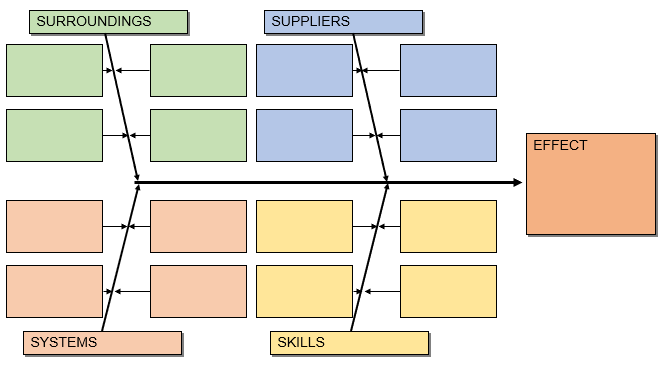Are you getting to the root of the problem?
20 March 2019

When problems occur in organisations, it is generally easiest to deal with the symptoms - for they are the immediately obvious manifestation of the problem and dealing with them is what gets recognition. So that’s exactly what we tend to do.
Something goes wrong. We fix it, replace it, or re-do it. Job done. Problem solved.
Something similar goes wrong. Once again, we fix it, replace it, or re-do it. Job done. Problem solved.
Or is it?
It’s not hard to notice a trend here, and an opportunity to be a little more efficient. Perhaps we might benefit from an investigation or analysis of the root causes of problems or events. Root cause analysis is based on the belief that we don’t just deal with the immediate problems but look to correcting or eliminating their root causes. By identifying - and then dealing with - root causes, the recurrence of problems will be minimized. Of course, it is not always possible to ensure the complete prevention of recurrence with just one round of applying control measures. Root cause analysis may need to be a re-iterative process.
Two of the more well-known tools used in root cause analysis are the 5 whys and cause and effect analysis.
The 5 Whys
The technique known as the 5 Whys is extremely simple yet can be very effective. It is repeatedly asking the question "Why?" to gradually delve below the surface problem and uncover its root causes. Of course, the number of questions does not actually have to be 5 - that's just a generalisation. It might also take 3, 4, or 6 questions to get there.
Using the 5 Whys does not require any special resources - just persistence. As any parent knows, children are naturally gifted at it!
Let’s look at an example.
The problem: An organization that provides catering to functions is getting customer complaints that they are not receiving the food they ordered. Sometimes it’s the wrong food, sometimes the wrong quantity, sometimes too early or too late. Using the 5 Whys technique, we can drill down from the initial symptom to a root cause.
- Why are they not receiving the food that they asked for?
Because the preparation team are working to a different list than the one that the customer authorised - Why is the preparation team working to a different list than the one that the customer authorised?
Because the customer authorises items on our order form, which should get entered in our order tracking software, but to save time, the sales person phones through the requirements – which are then written down by hand. Sometimes there are misunderstandings over what is meant - Why does that save time – isn’t using the software quick enough?
It is in theory, but while management and the preparation team have been trained on its use. The sales team haven’t been trained yet - Why haven’t the sales people had software training yet?
Because it’s in the budget for next year. Their training budget for this year has already been allocated – mostly on courses related to lead generation and sales techniques - Considering that sending the wrong food is a source of customer complaints, why wasn’t the training prioritised?
Because the Sales Manager chooses what to spend her training budget on and didn’t know about the problem of incorrect food deliveries – that’s not considered a sales issue, but a delivery issue.
So, drilling down from the initial symptoms is starting to reveal several root causes such as; the prioritisation of training, perhaps a lack of information flow to management, perhaps even incorrect categorisation of issues reported. We could of course, go further still. Hopefully, the above example clearly illustrates that the 5 Whys technique can be very useful in getting to the root causes of problems.
Cause and effect
Cause and effect analysis is based on the premise that many problems are not the direct result of a single cause, but the effect of a number of causes combined together. It can be very helpful in breaking down a seemingly mysterious or complex problem into a number of contributory causes. This can make a problem easier to understand and overcome.
The analysis is greatly assisted by using a Cause and Effect Diagram in the shape of a fish skeleton with the stated problem as the head. This is otherwise known as the Ishikawa diagram (after its originator Kaoru Ishikawa – one of the founding fathers of quality management) or Fishbone diagram. This diagram helps the user to trace problems back to originating or root causes and therefore lead to improvement from the bottom up.

The above illustration is from a template Word Document included in the Qudos Quality toolkit. This example is based on the 4S model of cause and effect diagram - which considers 4 main causal factors - Suppliers, Systems, Skills, and Surroundings. This model is typically used in service industries. There are also many other models in use such as:
- 4M model for manufacturing companies - with the following factors: Manpower, Machines, Methods and Materials
- 6 category model for manufacturing companies - with the following factors: Equipment, Process, People, Materials, Environment, and Management
- 4 category model for service sector organizations - with the following factors: Policies, Procedures, People, and Equipment
- 8P model for service sector organizations - with the following factors: Product, Price, Promotion, People, Processes, Place / Plant, Policies, Procedures
Some of the listings may seem to be a little contrived. For example, the 8P model particularly struggles in combining Place/Plant as one factor to keep the factors to an even number. Some of the labels also seem to be interchangeable e.g. Machines/Equipment, People/Manpower etc. Anyone using this technique should not feel constrained by any of these models but use the number of categories and labels that best suit the situation.
The Cause and Effect Diagram is probably best used by a group. Typically, the procedure is as follows:
- The effect or problem is listed at the head of the fishbone
- Decide on the primary-level causes or factors – use one of the models mentioned, or brainstorm your own ideas
- Numerous secondary-level causes may be identified within each of the primary-level causes or factors – once again, the brainstorming technique can be useful here
- (Optional) use the 5 whys technique to identify deeper causes
- Review as a group
- Plan actions
In addition to ‘brainstorming’ and ‘the 5 whys’ as mentioned above, various other management systems techniques may be used in conjunction with cause and effect analysis. For example, an Affinity diagram may be used to help you select the primary-level factors.
Knowledge is power
Of course, using the above techniques assumes that you are aware that there is a problem in the first place! Many organisational problems that occur time and again may be widely distributed over time and affect various personnel in different departments and locations. If the organization doesn’t have software to capture relevant information, and make it available for easy searching, they are prone to keep addressing the symptoms time and again without realising there is a systematic problem they could be looking at.
Those with integrated management system software such as Qudos 3 can quickly and easily run queries to identify similar problems and trends. Search criteria in that application include:
- How the issue was raised e.g. by a customer, by an employee, at an audit, meeting or risk assessment
- The main topic e.g. Quality, OHS, Environment, or Information Security
- Time period (from/to dates)
- Relevant location
- Relevant business unit
- The person that action was assigned to
- Text-based search – this might include any information that was entered about the problem e.g. relevant customer, equipment etc.
Qudos 3 also enables users to link an Action that deals with an initial problem, to up to 99 others that may cover a Root Cause Investigation and action plans to address any causes identified.
Example:

Enough is enough
From a philosophical point of view, the question can always be asked; but have you got to the real root cause yet? Given endless time and patience, a problem can be investigated on a deeper and deeper level. Fortunately, those of us involved in business management don’t have to be too philosophical. Generally, we only need to investigate down to the root cause level that we can do something about – what you might call the Fixable level. We also need to consider the old see-saw of costs and benefits. From a risk management point-of-view, is it better to eliminate the causes or just accept the problem? Will the fix cost more than the problem, or even cause other problems? The answers will of course be varied, but a little knowledge of the techniques mentioned in this article will hopefully assist you in getting to the root cause of at least some of the problems that your organisation faces.
What the standards say
While they don’t usually refer to ‘root cause analysis’ directly, just about all management system standards have a requirement for organizations to investigate problems and put corrective measures in place to avoid a potential problem occurring or a recurrence of known problems. In the current generation of ISO management system standards, the topic is generally referred to under Nonconformity and Corrective action in Clause 10.
Further Reading
Further discussion on improvement techniques and templates/examples are included in our toolkits – available in Qudos 3 software and QudosClub online resource centre.
